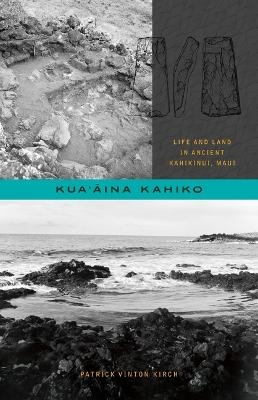
Kua‘āina Kahiko
Life and Land in Ancient Kahikinui, Maui
Seiten
2023
University of Hawai'i Press (Verlag)
978-0-8248-9681-2 (ISBN)
University of Hawai'i Press (Verlag)
978-0-8248-9681-2 (ISBN)
Follows kamaaina archaeologist Patrick Vinton Kirch on a seventeen-year-long research odyssey to rediscover the ancient patterns of life and land in Kahikinui. Rich with anecdotes of Kirch’s personal experiences over years of field research, this book takes the reader into the little-known world of the ancient kuaaina.
In early Hawai‘i, kua‘āina were the hinterlands inhabited by nā kua‘āina, or country folk. Often these were dry, less desirable areas where much skill and hard work were required to wrest a living from the lava landscapes. The ancient district of Kahikinui in southeast Maui is such a kua‘āina and remains one of the largest tracts of undeveloped land in the islands. Named after Tahiti Nui in the Polynesian homeland, its thousands of pristine acres house a treasure trove of archaeological ruins—witnesses to the generations of Hawaiians who made this land their home before it was abandoned in the late nineteenth century.
Kua‘āina Kahiko follows kama‘āina archaeologist Patrick Vinton Kirch on a seventeen-year-long research odyssey to rediscover the ancient patterns of life and land in Kahikinui. Through painstaking archaeological survey and detailed excavations, Kirch and his students uncovered thousands of previously undocumented ruins of houses, trails, agricultural fields, shrines, and temples. Kirch describes how, beginning in the early fifteenth century, Native Hawaiians began to permanently inhabit the rocky lands along the vast southern slope of Haleakalā. Eventually these planters transformed Kahikinui into what has been called the greatest continuous zone of dryland planting in the Hawaiian Islands. He relates other fascinating aspects of life in ancient Kahikinui, such as the capture and use of winter rains to create small wet-farming zones, and decodes the complex system of heiau, showing how the orientations of different temple sites provide clues to the gods to whom they were dedicated.
Kirch examines the sweeping changes that transformed Kahikinui after European contact, including how some maka'āinana families fell victim to unscrupulous land agents. But also woven throughout the book is the saga of Ka ‘Ohana o Kahikinui, a grass-roots group of Native Hawaiians who successfully struggled to regain access to these Hawaiian lands. Rich with anecdotes of Kirch’s personal experiences over years of field research, Kua'āina Kahiko takes the reader into the little-known world of the ancient kua‘āina.
In early Hawai‘i, kua‘āina were the hinterlands inhabited by nā kua‘āina, or country folk. Often these were dry, less desirable areas where much skill and hard work were required to wrest a living from the lava landscapes. The ancient district of Kahikinui in southeast Maui is such a kua‘āina and remains one of the largest tracts of undeveloped land in the islands. Named after Tahiti Nui in the Polynesian homeland, its thousands of pristine acres house a treasure trove of archaeological ruins—witnesses to the generations of Hawaiians who made this land their home before it was abandoned in the late nineteenth century.
Kua‘āina Kahiko follows kama‘āina archaeologist Patrick Vinton Kirch on a seventeen-year-long research odyssey to rediscover the ancient patterns of life and land in Kahikinui. Through painstaking archaeological survey and detailed excavations, Kirch and his students uncovered thousands of previously undocumented ruins of houses, trails, agricultural fields, shrines, and temples. Kirch describes how, beginning in the early fifteenth century, Native Hawaiians began to permanently inhabit the rocky lands along the vast southern slope of Haleakalā. Eventually these planters transformed Kahikinui into what has been called the greatest continuous zone of dryland planting in the Hawaiian Islands. He relates other fascinating aspects of life in ancient Kahikinui, such as the capture and use of winter rains to create small wet-farming zones, and decodes the complex system of heiau, showing how the orientations of different temple sites provide clues to the gods to whom they were dedicated.
Kirch examines the sweeping changes that transformed Kahikinui after European contact, including how some maka'āinana families fell victim to unscrupulous land agents. But also woven throughout the book is the saga of Ka ‘Ohana o Kahikinui, a grass-roots group of Native Hawaiians who successfully struggled to regain access to these Hawaiian lands. Rich with anecdotes of Kirch’s personal experiences over years of field research, Kua'āina Kahiko takes the reader into the little-known world of the ancient kua‘āina.
Patrick Vinton Kirch is professor of anthropology at the University of Hawai‘i at Mānoa, and professor emeritus at the University of California, Berkeley.
| Erscheinungsdatum | 03.04.2023 |
|---|---|
| Zusatzinfo | 80 illustrations, 5 maps |
| Verlagsort | Honolulu, HI |
| Sprache | englisch |
| Maße | 152 x 229 mm |
| Themenwelt | Geisteswissenschaften ► Archäologie |
| Geisteswissenschaften ► Geschichte ► Regional- / Ländergeschichte | |
| ISBN-10 | 0-8248-9681-5 / 0824896815 |
| ISBN-13 | 978-0-8248-9681-2 / 9780824896812 |
| Zustand | Neuware |
| Informationen gemäß Produktsicherheitsverordnung (GPSR) | |
| Haben Sie eine Frage zum Produkt? |


